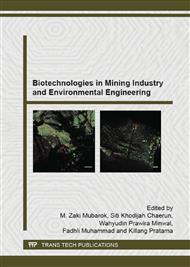p.7
p.11
p.15
p.19
p.23
p.28
p.32
p.36
p.40
Dyp-Type Peroxidase (DypA) from the Bioleaching Acidophilic Bacterium Leptospirillum ferriphilum DSM 14647
Abstract:
Leptospirillum ferriphilum is an acidophilic iron-oxidizing bacterium that is relevant for chemical leaching of sulfide ores. In the extremely acidic conditions found in bioleaching operations, this microorganism deals with an abundant supply of soluble iron and other metals that might induce oxidative damage to biomolecules through the generation of reactive oxygen species (ROS). We evaluated the role of Dyp-type peroxidase in the protection against oxidative stress in L. ferriphilum DSM14647. The genetic region encoding dypA was cloned and sequenced. The predicted DypA enzyme is 295 amino acids long with an estimated molecular mass of 32.9 kDa containing a highly conserved peroxide reduction motif. Genetic complementation of catalases/peroxidases-deficient Escherichia coli cells indicated that expression of dypA from L. ferriphilum restored the resistance to hydrogen proxide to levels exhibited by the wild type strain. Exposure of L. ferriphilum to hydrogen peroxide leads to a significant transcriptional activation of dypA suggesting its involvement in the response to oxidative stress in this bacterium. This is the first Dyp-type peroxidase characterized from an acidophilic microorganism, making it a potential candidate for research in basic and applied biology.
Info:
Periodical:
Pages:
23-27
Citation:
Online since:
November 2015
Price:
Сopyright:
© 2015 Trans Tech Publications Ltd. All Rights Reserved
Share:
Citation:


